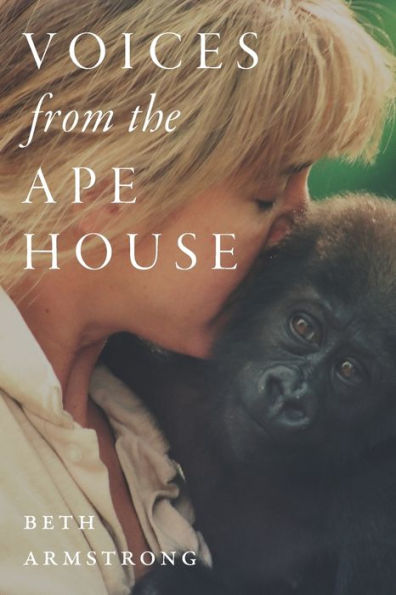

Paperback(1)
-
PICK UP IN STORECheck Availability at Nearby Stores
Available within 2 business hours
Related collections and offers
Overview

Product Details
| ISBN-13: | 9780814255711 |
|---|---|
| Publisher: | Ohio State University Press |
| Publication date: | 03/10/2020 |
| Edition description: | 1 |
| Pages: | 312 |
| Sales rank: | 670,579 |
| Product dimensions: | 6.00(w) x 8.90(h) x 1.10(d) |
| Age Range: | 16 - 18 Years |
About the Author
Read an Excerpt
It is always the smell I remember. Opening the back kitchen door to the Ape House lets loose a wave of gorilla—a thick deep pungent odor that envelops me as I unlock the door to let myself in. The aroma rolls out, dissipating into the early morning cool. By end of day, I will smell like a gorilla, their perfume clinging to my clothes, my hair, my skin.
The gorillas hear me. The click of the huge padlock alerts them that I have arrived and another day has begun. I hear their welcoming vocalizations, a deep rumbling, each greeting as distinct as the individual animal that elicits it. I cross the kitchen to the solid wooden sliding door that opens to the back keeper aisle and unlock it. As I slide it to the right, it reveals Colo, the first gorilla born in captivity, the matriarch of our gorillas, sitting in her usual dignified way at her barred back door. She has half a grapefruit husk perched snug on her head, perfectly balanced on her sagittal crest. A crown, if you will. She looks at me in such a dead-on serious way— I turn away to hide my smile. She looks silly, so sincere and thoroughly imperial. How does she pull it off?
“Good Morning, Colo,” I say as she carefully watches me. I have never been one of her favorites. Our initial meeting on my first day in the Ape House didn’t go well and I don’t think she has ever forgotten or forgiven me. She tolerates me, but I don’t think she’s overly fond of me. Colo is one of the most beautiful gorillas I will ever meet. The contours of her face are heart shaped; her brown eyes are penetrating with an unusual rim of light gray around each iris. Her hands and feet are long and narrow. Her fingers and toes are equally long. In a word, they are elegant. Her coal-black skin is flawlessly uniform, her thick hair coat healthy and a deep black. She has grayed out as she has gotten older, but she has none of the reddish hair on her head that many of our other females have. She reminds me of a New York City matron from a well-to-dofamily: always smartly turned out, hair and make-up in place, wearing the perfect Chanel suit.
I turn back to the kitchen, start a pot of coffee, soak the eight food bins filled with vegetables and fruit, and then grab the vitamin bottles and begin my walk down the back aisle, distributing vitamins to each of the gorillas. This daily morning walk ensures that the gorillas receive their vitamin C and multivitamin tablets. But more importantly, it allows us to check on them, to give them a quick look-see to make sure all is OK. Over the years, this walk will reveal much heartache and joy. It will make known that in the depths of the night their lives went on without us, that babies were born, beloved troop members died—a daily reminder that wereally are periphery to their complicated lives. We may be charged with “keeping” them, but they never will be “ours.”
We keepers are the fortunate few in this world to bear witness to their lives, to every once in a while be asked to join in a bout of play or chase, to be accepted as an observer watching the careful tenderness of a silverback touching his newborn son for the first time, or to unexpectedly come upon a boisterous round of tickling between two usually reserved adults, and backing away quietly so as not to interrupt them. We few hear the sad mourning call after the death of a troop member, the haunting refrain wafting through the Ape House, its tender tendrils looking into every nook and cranny as if searching for the lost group member. We are, quite simply, privileged.
Table of Contents
Chapter 1 Ape HouseChapter 2 Childhood
Chapter 3 Clarity
Chapter 4 Primate Behavior 101
Chapter 5 Beginnings
Chapter 6 Chimpanzees
Chapter 7 Rebels
Chapter 8 Dispelling Myths
Chapter 9 Leadership
Chapter 10 An Extraordinary Year
Chapter 11 Construction
Chapter 12 Bongo
Chapter 13 Back to the Children’s Zoo
Chapter 14 More Primate Experience
Chapter 15 A Bigger World
Chapter 16 Apenheul
Chapter 17 Back to Gorillas
Chapter 18 Toni-Baloney
Chapter 19 Moments of Magic
Chapter 20 The Kitchen Table and Front Bench
Chapter 21 Humans and Gorillas
Chapter 22 Oscar
Chapter 23 Holidays
Chapter 24 Intrusions and Mistakes
Chapter 25 A Family
Chapter 26 Building a Gorilla Troop
Chapter 27 Creative Sparks
Chapter 28 Learning to Be a Gorilla
Chapter 29 Keeper Etiquette
Chapter 30 Bridgette, Bongo, and Fossey
Chapter 31 What’s in a Name?
Chapter 32 Everyone Has a Story
Chapter 33 Lulu—a Game Changer
Chapter 34 A New Life for Bathsheba
Chapter 35 Behind the Scenes
Chapter 36 Monumental Changes
Chapter 37 Rainy Days
Chapter 38 Storytelling
Chapter 39 Something Bigger than Us
Chapter 40 Friends
Chapter 41 Mosuba’s Road Trip
Chapter 42 People I Have Met
Chapter 43 Molly
Chapter 44 Saturday Nights
Chapter 45 Bongo and Fossey
Chapter 46 Mumbah and Pongi
Chapter 47 Social Beings
Chapter 48 Why We Do Conservation
Chapter 49 Teenagers
Chapter 50 Voices Past and Present
Afterword
